Ounce of Wisdom
July 28th, 2008, by Ben
I stumbled upon a useful bit of knowledge today. Since many of you, like me, are not professionally trained in the language of recipese, I thought I should share.
When a recipe calls for “1 ¼-oz. unflavored gelatin”, this means to use one packet, a quarter-ounce in size (the standard size dry packet). It does NOT mean to use 1¼ OUNCES (a whole box) of gelatin. Of sticky, gooey, solid-as-a-jiggly-rock-when-you-use-five-times-the-recommended-amount gelatin.
And that’s all I have to say about that.
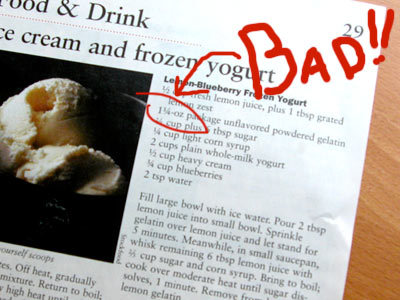
PS: Also, should you happen to make that (very understandable, and natural, and possibly even commendable) mistake, I'd recommend that you detach the whisk and throw out the concoction (whole, as a single piece of... whatever it is) instead of trying to flush it down the drain. I would imagine (imagine! no direct experience!) that the drain would resist.
PPS: Also recommended is waiting for your spouse to be away for the day when trying new recipes, especially those with poorly thought-out typographic conventions. And have extra Liquid Plumr on hand at all times.
Passatelli in brodo
June 20th, 2008, by Francesca
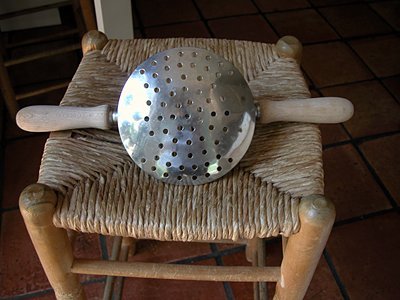
Remember the dish I picked for my interpretation of Chicken Noodle Soup a few weeks ago? That was passatelli in brodo, a typical broth dish from Romagna, more specifically from Lugo di Romagna, a small town near Faenza, where I spent most of my time growing up. I love passatelli in brodo. It's a winter dish, but if I get a twinge of homesickness or food nostalgia, I don't care what time of year it is. Call it comfort food or whatever; it's the kind of thing that just makes me feel better.
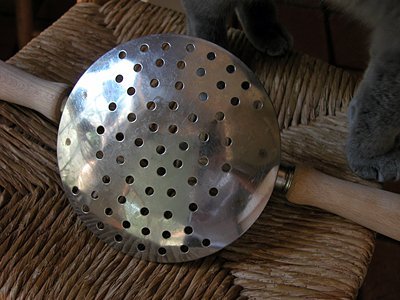
I know most of my readers are in the northern hemisphere, but at least a couple are down under (hi, Steve and Gaby!) so this might be a timely recipe for them and the rest of you can just file it away for next winter.
If it weren't for the liquid/puréed diet I am on for another couple of days, I would not have made passatelli on a day like this: 106ºF (41ºC). Yes, it's insane, but there's only so much yogurt and ice-cream I can eat in one day.
The strange looking thing in the photos above is the traditional tool used in Romagna to make passatelli, but…
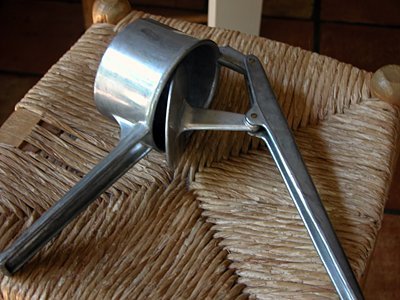
a ricer like this one will do just fine.
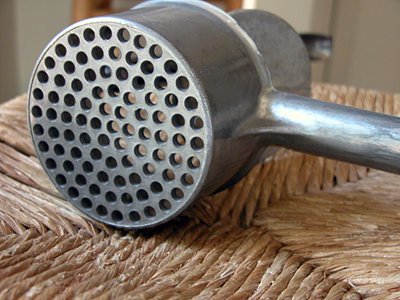
Ingredients (serves 4)
- 100 gr
- Parmesan cheese, grated
- 100 gr
- breadcrumbs, small
- 3
- eggs
- 1 lt
- chicken broth
- 30 gr
- butter
- nutmeg
- salt
- black pepper
- lemon zest (optional)
In a bowl, mix the breadcrumbs and Parmesan cheese with the melted butter, the whole eggs, a pinch of nutmeg, a big pinch of salt, the ground black pepper and the lemon zest. I've only recently started to add the lemon zest and I like the brightness it brings to the dish. I go easy on lemon zest, pepper and nutmeg.
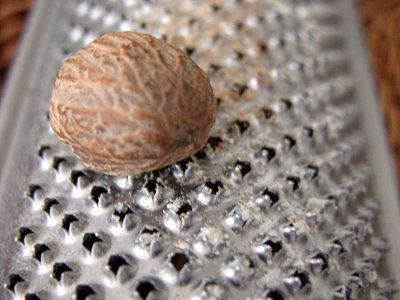
The mixture has to be rather stiff; if it’s too soft, add more breadcrumbs and Parmesan. Mine was a little too stiff this time and my little worms broke too soon. Part of the problem was that I didn't have good breadcrumbs.
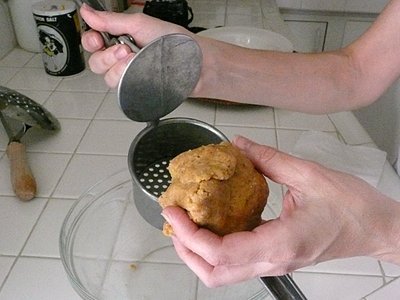
Pass the mixture through the ricer (it has to offer a good resistance) and cut the little “worms” when they are about 2 inches long. You could even do this over the boiling broth.
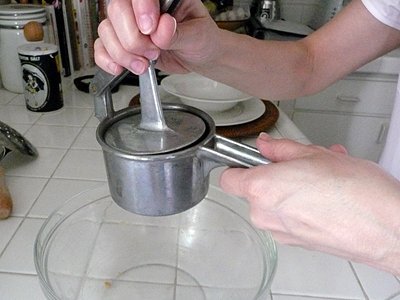

I should have dropped the passatelli on a tray and spaced them apart, but I forgot.
Bring the seasoned broth to boil in a pot, and drop the passatelli. They cook in less than 5 minutes. Serve immediately.
In the past few years, restaurants in Romagna have started to cook passatelli in broth and then drain them to serve them pasta-style with ragù or other condiments. I haven't tried them that way yet, so I don't have an opinion. Next time I go to Italy, I'll put that on my to do list.
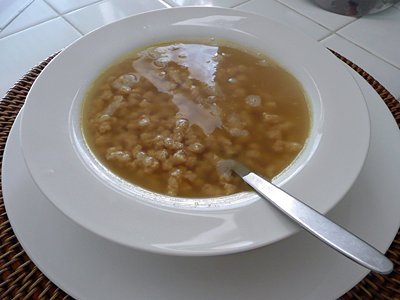
By the way, this is a dish that really benefits from a good homemade broth, and the perfect broth for it would be brodo di cappone (capon broth) or brodo di manzo e gallina (beef and hen broth). Passatelli are one of several traditional Christmas dishes in Romagna, usually followed by bollito misto, mixed boiled meat and vegetables used to make the broth. I admit that I didn't make my own broth today and the dish suffered from that.
For those of you who like their broth super clear – consommè style – this may not be your cup of tea, as the passatelli tend to cloud the broth. Like most (all?) dishes from my beloved Romagna, this is a rustic plate.
Oh, one more thing… use the best Parmigiano you can find (Parmigiano Reggiano, freshly grated) and whatever bread you choose, please don't use sourdough or you'll make me cry.
Salame al cioccolato
June 15th, 2008, by Francesca
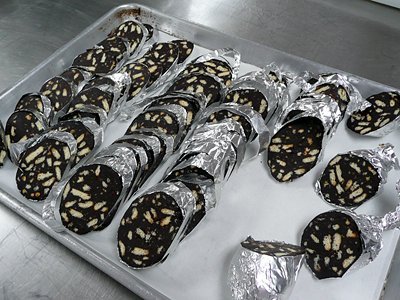
The bad news: this is a calorie bomb. Be warned and don't come complaining to me when those jeans don't fit; I won't have any of that.
The good news: it's super easy – messy, but easy – and there is no cooking involved. Oh, and you get a good upper body work-out, too, to offset some of those calories.
Warning: this contains raw eggs. I never worry about this, coming from the land of zabaglione and spaghetti alla carbonara, but if you do, consider using pasteurized eggs.
Ingredients:- 2
- egg yolks
- 100 g
- fine sugar
- 100 g
- unsalted butter
- 100 g
- unsweetened cocoa powder
- 1
- small glass of rum
- 150 g
- dry tea biscuits
- Equipment:
- stainless steel or glass mixing bowl
- wooden spoon (reserved for desserts only)
- strainer/sieve
- scale
A note about measurements:
If your scale doesn't do metric, remember 100 grams = about 3.5 ounces. If you have no scale, then I'm no help because I use metric or US systems based on the recipe at hand, but I hardly ever try to convert from one to the other. Brain hurts… but I should be more helpful after I take Applied Math next term.
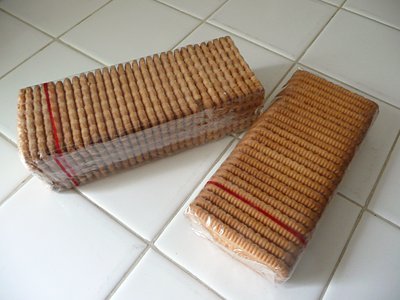
Dry tea biscuits (biscotti secchi): I bought mine at a local Armenian store. Any kind of dry biscuit/cookie will do.
Directions
Mix the sugar with the egg yolks until soft and light in color.
Incorporate the butter, preferably softened at room temperature. I am a little impatient and run it in the microwave oven until very soft, but stop before it melts as that changes the taste and texture. I also let it cool before using it, so it doesn't cook the egg yolks.
Start adding the cocoa powder through a strainer of your choice. Mix as you incorporate the cocoa powder. By the time you are halfway through the cocoa powder, the compound will be getting hard to stir. This is a good time to start adding the rum. I like to add a little at a time to adjust the consistency as needed. When it gets to a good point where I judge that I can start adding dry ingredients again, I resume adding the cocoa powder until it's all incorporated. You may need to add a few drops of rum again. Use your judgement.
You should now have a dense, homogenous mixture, like a thick mud. Time to break those dry biscuits. Just crumble them with your hands, enough that you don't have huge pieces but not so that you end up with biscuit flour. You need chunks, because those are the pieces that look like little lard chunks when you cut your salame in slices.
Add the broken biscuits to your mixture and work it with your hands until everything is incorporated. Now take a sheet of aluminum foil and put your chocolate mud on it. Shape it like a salame (a long cylinder), wrap the foil around it and put in the freezer for 1h to 1h30', then move it to the fridge. This will get your salame to stiffen up as quickly as possible. If you are not in a hurry, you can simply put the salame in the fridge overnight. I am not really into the delayed gratification thing, so I go the freezer way.
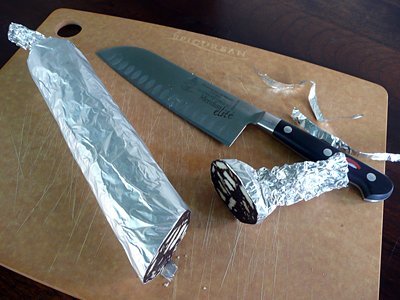 Possible variations
Possible variations
You can replace the rum with Amaretto di Saronno or another sweet liquor, or forgo alcohol altogether if children are involved. In that case, think of ways to keep the mixture moist enough, perhaps by using an extra egg yolk or a smaller ratio of dry ingredients. You've made desserts before; be creative.
You could also incorporate toasted almonds in the mix. Again, think of how this might affect the end result and compensate accordingly. I would probably reduce the amount of dry biscuits in that case.
Something I might try next time is a different packaging, maybe some kind of paper instead of the aluminum foil, but I am not sure yet. It depends on whether I can make the paper stick to the salame before and after cutting it in slices. I like to keep the external "peel" as it feels like the rind of real salame. Another reason is that salame al cioccolato is very buttery and easier to cut when wrapped in something.
P.S.
Ah, yes… as MaryJo pointed out in a comment to yesterday's post, you may want to use your not-so-good knife to cut through the foil. The things I do before my morning caffeine…
Chicken Roulade
May 30th, 2008, by Francesca
In addition to the beef steak with Bordelaise sauce, yesterday we cooked chicken roulade. It was a hard day of intense cooking where we had to stay highly focused to finish all our dishes within the allotted time windows. At one point I thought I would not be able to deliver, but in the end I managed to present both dishes in time. It's all about planning and it's not easy – at least not for me – but I am getting better at it.
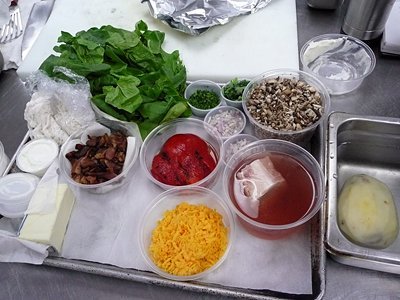
Mise en place for some of the roulade and the steak dish.
The chicken roulade starts with pounding a chicken breast until it's consistently thin. You have to be careful not to punch holes into it, though.
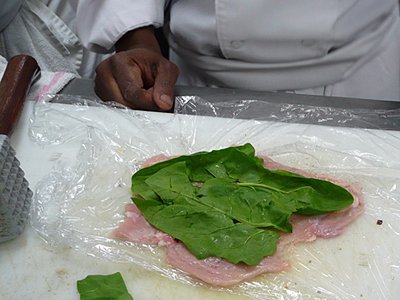
After pounding the chicken breast, you place spinach leaves on it.
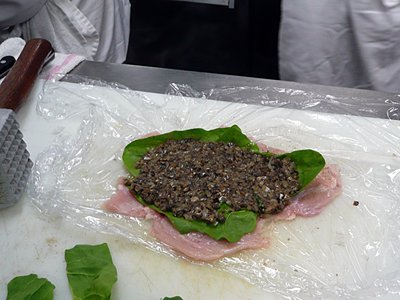
Then you spread mushroom Duxelle on the spinach. To make mushroom Duxelle you sweat some minced shallot in a pan and then add finely chopped button or cremini mushrooms until you eliminate all liquid and they start to color.
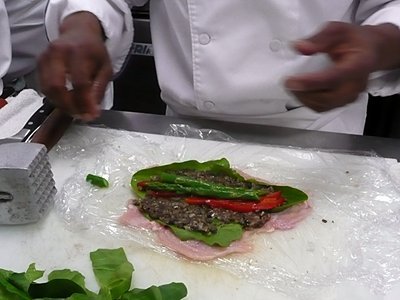
Next, you add a few strips of roasted red bell pepper (roasted directly on a burner until charred, then wrapped in plastic wrap for a while and peeled) and a couple of asparagus stalks (blanched, shocked in ice and dried).
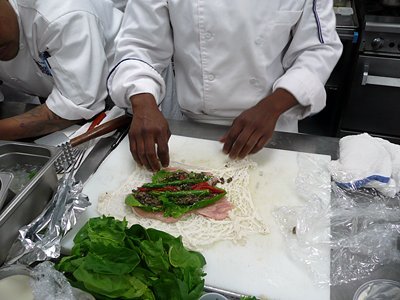
If you havent' already done so, place the chicken and other ingredients on a piece of caul fat. Caul fat is the lining of a pig's stomach and is used to wrap meat. It looks a bit gross, but most of it dissolves during cooking.
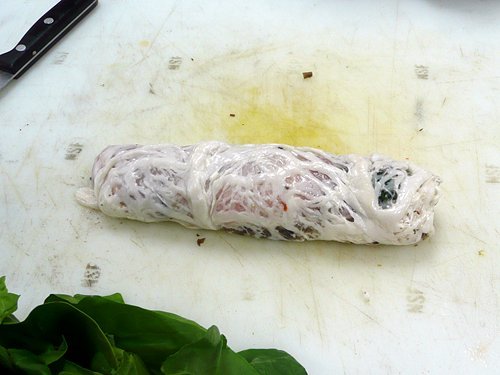
Once you've wrapped your chicken roulade in caul fat, sear it in a hot pan starting with the seam down, to ensure that the roll doesn't fall apart. Then sear all around until the roulade is a light golden brown. At this point, put it in foil wrap, keeping it slightly open, and place it in the oven at 375º F for 20-25 min.
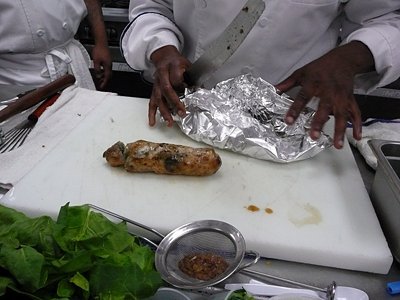
This is your roulade when it comes out of the oven, ready to be cut.
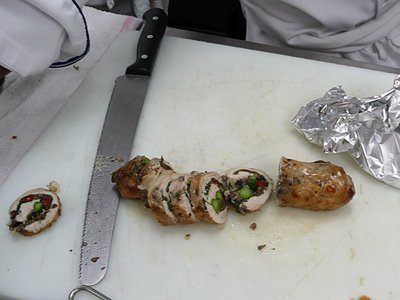
Here it's cut straight, but you can also cut it on the bias.
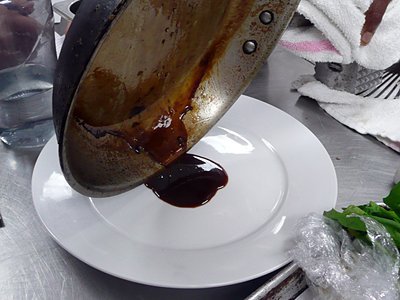
This is the plating sequence. First the Port wine sauce, a reduction of shallots and Port wine, strained and put back in the pan adding brown veal stock until it reaches the desired consistency.
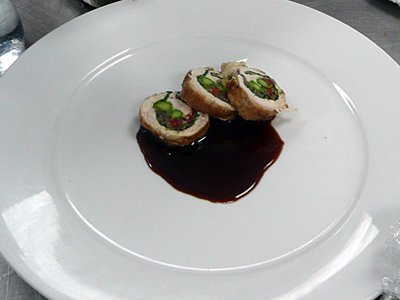
Then a few slices of the chicken roulade. By the way, this is meant to be an appetizer, not an entrée, which explains the small serving size.
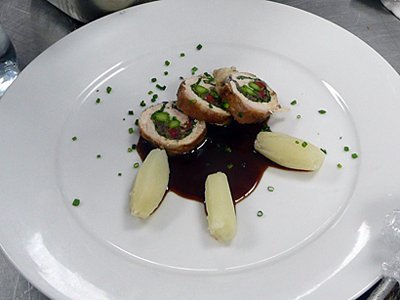
A few pommes vapeur (steamed potato tournées) and voilà, the dish is done. The picture above is the chef's demo.
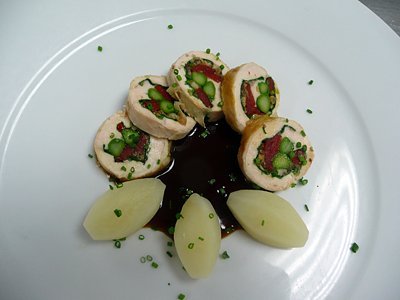
And the one below is my own. My potato tournés were a bit underdone, but the roulade was just right. :)



